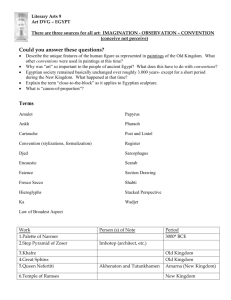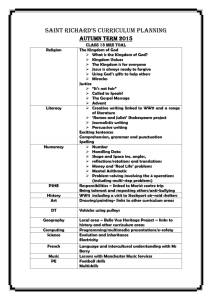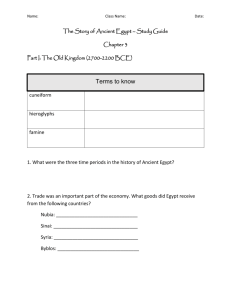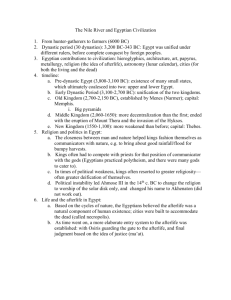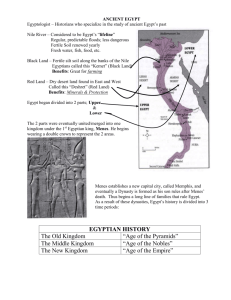Click here - Test Bank Doctor
advertisement
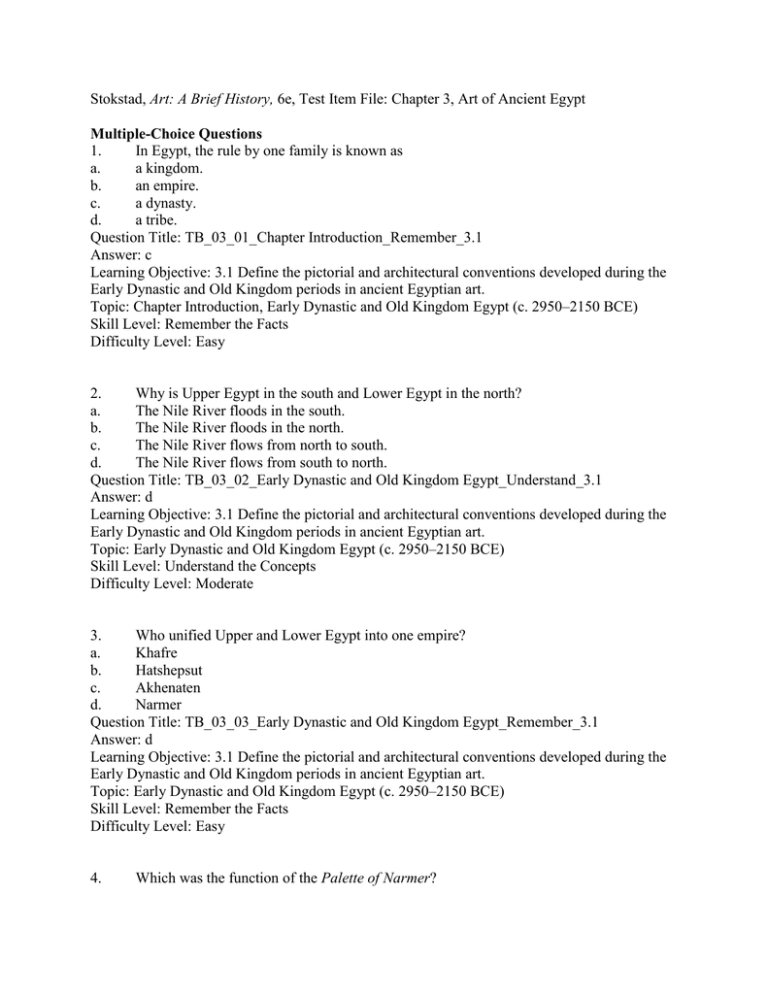
Stokstad, Art: A Brief History, 6e, Test Item File: Chapter 3, Art of Ancient Egypt Multiple-Choice Questions 1. In Egypt, the rule by one family is known as a. a kingdom. b. an empire. c. a dynasty. d. a tribe. Question Title: TB_03_01_Chapter Introduction_Remember_3.1 Answer: c Learning Objective: 3.1 Define the pictorial and architectural conventions developed during the Early Dynastic and Old Kingdom periods in ancient Egyptian art. Topic: Chapter Introduction, Early Dynastic and Old Kingdom Egypt (c. 2950–2150 BCE) Skill Level: Remember the Facts Difficulty Level: Easy 2. Why is Upper Egypt in the south and Lower Egypt in the north? a. The Nile River floods in the south. b. The Nile River floods in the north. c. The Nile River flows from north to south. d. The Nile River flows from south to north. Question Title: TB_03_02_Early Dynastic and Old Kingdom Egypt_Understand_3.1 Answer: d Learning Objective: 3.1 Define the pictorial and architectural conventions developed during the Early Dynastic and Old Kingdom periods in ancient Egyptian art. Topic: Early Dynastic and Old Kingdom Egypt (c. 2950–2150 BCE) Skill Level: Understand the Concepts Difficulty Level: Moderate 3. Who unified Upper and Lower Egypt into one empire? a. Khafre b. Hatshepsut c. Akhenaten d. Narmer Question Title: TB_03_03_Early Dynastic and Old Kingdom Egypt_Remember_3.1 Answer: d Learning Objective: 3.1 Define the pictorial and architectural conventions developed during the Early Dynastic and Old Kingdom periods in ancient Egyptian art. Topic: Early Dynastic and Old Kingdom Egypt (c. 2950–2150 BCE) Skill Level: Remember the Facts Difficulty Level: Easy 4. Which was the function of the Palette of Narmer? a. a breastplate b. a shield c. a place to grind paint for eye makeup d. a stele to honor the king Question Title: TB_03_04_Early Dynastic and Old Kingdom Egypt_Understand_3.1 Answer: c Learning Objective: 3.1 Define the pictorial and architectural conventions developed during the Early Dynastic and Old Kingdom periods in ancient Egyptian art. Topic: Early Dynastic and Old Kingdom Egypt (c. 2950–2150 BCE) Skill Level: Understand the Concepts Difficulty Level: Moderate 5. The Egyptian convention of depicting shoulders and torso in a frontal manner and hips, legs, and feet in profile was used a. when depicting slaves. b. when depicting priests. c. when depicting royalty. d. when depicting commoners. Question Title: TB_03_05_Early Dynastic and Old Kingdom Egypt_Understand_3.1 Answer: c Learning Objective: 3.1 Define the pictorial and architectural conventions developed during the Early Dynastic and Old Kingdom periods in ancient Egyptian art. Topic: Early Dynastic and Old Kingdom Egypt (c. 2950–2150 BCE) Skill Level: Understand the Concepts Difficulty Level: Moderate 6. In Egypt, which of the following would be portrayed most naturalistically? a. a king b. a military leader c. a queen d. a person of lesser social rank Question Title: TB_03_06_Early Dynastic and Old Kingdom Egypt_Understand_3.1 Answer: d Learning Objective: 3.1 Define the pictorial and architectural conventions developed during the Early Dynastic and Old Kingdom periods in ancient Egyptian art. Topic: Early Dynastic and Old Kingdom Egypt (c. 2950–2150 BCE) Skill Level: Understand the Concepts Difficulty Level: Moderate 7. a. b. c. Which is a city of the dead? mastaba sarcophagus necropolis d. mausoleum Question Title: TB_03_07_Early Dynastic and Old Kingdom Egypt_Remember_3.1 Answer: c Learning Objective: 3.1 Define the pictorial and architectural conventions developed during the Early Dynastic and Old Kingdom periods in ancient Egyptian art. Topic: Early Dynastic and Old Kingdom Egypt (c. 2950–2150 BCE) Skill Level: Remember the Facts Difficulty Level: Easy 8. Who designed the funerary complex and stepped pyramid of Djoser? a. Djoser b. Imhotep c. Menkaure d. Menes Question Title: TB_03_08_Early Dynastic and Old Kingdom Egypt_Remember_3.1 Answer: b Learning Objective: 3.1 Define the pictorial and architectural conventions developed during the Early Dynastic and Old Kingdom periods in ancient Egyptian art. Topic: Early Dynastic and Old Kingdom Egypt (c. 2950–2150 BCE) Skill Level: Remember the Facts Difficulty Level: Easy 9. Which Third Dynasty king is buried at Saqqara? a. Senusret III b. Djoser c. Ramses II d. Hatshepsut Question Title: TB_03_9_Early Dynastic and Old Kingdom Egypt_Remember_3.1 Answer: b Learning Objective: 3.1 Define the pictorial and architectural conventions developed during the Early Dynastic and Old Kingdom periods in ancient Egyptian art. Topic: Early Dynastic and Old Kingdom Egypt (c. 2950–2150 BCE) Skill Level: Remember the Facts Difficulty Level: Easy 10. The oldest and largest of the Giza pyramids is that of a. Djoser. b. Khafre. c. Khufu. d. Menkaure. Question Title: TB_03_10_Early Dynastic and Old Kingdom Egypt_Remember_3.1 Answer: c Learning Objective: 3.1 Define the pictorial and architectural conventions developed during the Early Dynastic and Old Kingdom periods in ancient Egyptian art. Topic: Early Dynastic and Old Kingdom Egypt (c. 2950–2150 BCE) Skill Level: Remember the Facts Difficulty Level: Easy 11. In the Egyptian religion, who was the falcon-headed god? a. Thoth b. Ammit c. Anubis d. Horus Question Title: TB_03_11_Early Dynastic and Old Kingdom Egypt_Remember_3.1 Answer: d Learning Objective: 3.1 Define the pictorial and architectural conventions developed during the Early Dynastic and Old Kingdom periods in ancient Egyptian art. Topic: Early Dynastic and Old Kingdom Egypt (c. 2950–2150 BCE) Skill Level: Remember the Facts Difficulty Level: Easy 12. How was portraiture different during Egypt’s Middle Kingdom? a. It was not included in tombs. b. It showed more emotion. c. It displayed more idealism. d. It was larger in scale. Question Title: TB_03_12_Middle Kingdom_Understand_3.2 Answer: b Learning Objective: 3.2 Recognize the subtle changes to the conventions of ancient Egyptian art during the Middle Kingdom. Topic: Middle Kingdom (c. 1975–1640 BCE) Skill Level: Understand the Concepts Difficulty Level: Moderate 13. What is the significance of Funerary Stele of Amenemhat? a. It displays the success and harmony of dynastic rule. b. It represents the politics of the time. c. It shows military power of the government. d. It presents unity and confidence. Question Title: TB_03_13_Middle Kingdom_Understand_3.2 Answer: d Learning Objective: 3.2 Recognize the subtle changes to the conventions of ancient Egyptian art during the Middle Kingdom. Topic: Middle Kingdom (c. 1975–1640 BCE) Skill Level: Understand the Concepts Difficulty Level: Moderate 14. Why was Hatshepsut portrayed as a male king? a. She was not of royal blood and used her image to validate her reign. b. She was a warrior and led many successful battles. c. There was not artistic tradition for a female ruler. d. There was not a legitimate heir and she pretended to be a male king. Question Title: TB_03_14_New Kingdom_Understand_3.3 Answer: a Learning Objective: 3.3 Distinguish the refinements and transformations that occurred in the New Kingdom. Topic: New Kingdom (c. 1539–1075) Skill Level: Understand the Concepts Difficulty Level: Moderate 15. Who was the first king of Egypt to use the title “Pharaoh”? a. Djoser b. Tutmose III c. Narmer d. Khafre Question Title: TB_03_15_New Kingdom_Remember_3.3 Answer: b Learning Objective: 3.3 Distinguish the refinements and transformations that occurred in the New Kingdom. Topic: New Kingdom (c. 1539–1075) Skill Level: Remember the Facts Difficulty Level: Easy 16. Which term describes a massive gateway to a sanctuary, such as the Great Temple of Amun at Karnak? a. clerestory b. dolmen c. capital d. pylon Question Title: TB_03_16_New Kingdom_Remember_3.3 Answer: d Learning Objective: 3.3 Distinguish the refinements and transformations that occurred in the New Kingdom. Topic: New Kingdom (c. 1539–1075) Skill Level: Remember the Facts Difficulty Level: Easy 17. Which of the following is a massive gateway? a. clerestory b. hypostyle c. pylon d. dolmen Question Title: TB_03_17_New Kingdom_Remember_3.3 Answer: c Learning Objective: 3.3 Distinguish the refinements and transformations that occurred in the New Kingdom. Topic: New Kingdom (c. 1539–1075) Skill Level: Remember the Facts Difficulty Level: Easy 18. Which of the following are windows above a side roof that let light into the central interior space? a. pylons b. hypostyle c. bracketing d. clerestory Question Title: TB_03_18_New Kingdom_Remember_3.3 Answer: d Learning Objective: 3.3 Distinguish the refinements and transformations that occurred in the New Kingdom. Topic: New Kingdom (c. 1539–1075) Skill Level: Remember the Facts Difficulty Level: Easy 19. The reign of Akhenaten is also known as the a. Amarna period. b. Second Intermediate period. c. Babylonian Captivity. d. Ptolemaic period. Question Title: TB_03_19_New Kingdom_Remember_3.3 Answer: a Learning Objective: 3.3 Distinguish the refinements and transformations that occurred in the New Kingdom. Topic: New Kingdom (c. 1539–1075) Skill Level: Remember the Facts Difficulty Level: Easy 20. a. b. What was unusual about Egypt during the reign of Akhenaten? It was monotheistic. Slavery was abolished. c. Images of gods were outlawed. d. It was ruled by the Hyksos. Question Title: TB_03_20_New Kingdom_Understand_3.3 Answer: a Learning Objective: 3.3 Distinguish the refinements and transformations that occurred in the New Kingdom. Topic: New Kingdom (c. 1539–1075) Skill Level: Understand the Concepts Difficulty Level: Moderate 21. Where was the bust of Nefertiti discovered? a. on the prow of a ship b. in her tomb c. in a sculptor’s studio d. in the palace of neighboring Nubia Question Title: TB_03_21_New Kingdom_Understand_3.3 Answer: c Learning Objective: 3.3 Distinguish the refinements and transformations that occurred in the New Kingdom. Topic: New Kingdom (c. 1539–1075) Skill Level: Understand the Concepts Difficulty Level: Moderate 22. In the Egyptian religion, who was the god of the dead and the underworld? a. Osiris b. Ammit c. Isis d. Horus Question Title: TB_03_22_New Kingdom_Remember_3.3 Answer: a Learning Objective: 3.3 Distinguish the refinements and transformations that occurred in the New Kingdom. Topic: New Kingdom (c. 1539–1075) Skill Level: Remember the Facts Difficulty Level: Easy 23. In the Egyptian religion, who oversaw funerals and cemeteries and was represented with a jackal’s head? a. Osiris b. Ammit c. Anubis d. Horus Question Title: TB_03_23_New Kingdom_Understand_3.3 Answer: c Learning Objective: 3.3 Distinguish the refinements and transformations that occurred in the New Kingdom. Topic: New Kingdom (c. 1539–1075) Skill Level: Understand the Concepts Difficulty Level: Moderate 24. In the Egyptian religion, who was the “Eater of the Dead”? a. Thoth b. Ammit c. Anubis d. Horus Question Title: TB_03_24_New Kingdom_Remember_3.3 Answer: b Learning Objective: 3.3 Distinguish the refinements and transformations that occurred in the New Kingdom. Topic: New Kingdom (c. 1539–1075) Skill Level: Remember the Facts Difficulty Level: Easy 25. The “Books of the Dead” were a. books of prayers. b. collections of magic spells. c. collections of songs. d. lists of ancient kings. Question Title: TB_03_25_New Kingdom_Remember_3.3 Answer: b Learning Objective: 3.3 Distinguish the refinements and transformations that occurred in the New Kingdom. Topic: New Kingdom (c. 1539–1075) Skill Level: Remember the Facts Difficulty Level: Easy 26. Ptolemaic mummy portraits were painted using what medium? a. encaustic b. fresco c. oil d. watercolor Question Title: TB_03_26_Late Egyptian Art_Remember_3.4 Answer: a Learning Objective: 3.4 Identify both traditional and new features seen in Late Egyptian art. Topic: Late Egyptian Art Skill Level: Remember the Facts Difficulty Level: Easy 27. What event officially ended the Ancient Egyptian dynastic culture? a. the death of Cleopatra VII b. the death of Marc Antony c. the death of Alexander the Great d. the death of Tutankhamun Question Title: TB_03_27_Late Egyptian Art_Understand_3.4 Answer: a Learning Objective: 3.4 Identify both traditional and new features seen in Late Egyptian art. Topic: Late Egyptian Art Skill Level: Understand the Concepts Difficulty Level: Moderate Essay Questions 28. How did the Egyptians’ beliefs about the afterlife influence their art and architecture? Question Title: TB_03_28_Early Dynastic and Old Kingdom Egypt_Apply and Analyze_3.1 Essay responses should include these points: Egyptians built massive and monumental structures to house the bodies of the dead. Mummies were created to house the ka, or spirit, which lived on after the death of the body and forever engaged in activities it had enjoyed during its earthly existence. Elaborate paintings and reliefs often decorated the interiors of tombs of royalty and wealthy individuals. Learning Objective: 3.1 Define the pictorial and architectural conventions developed during the Early Dynastic and Old Kingdom periods in ancient Egyptian art. Topic: Early Dynastic and Old Kingdom Egypt (c. 2950–2150 BCE) Skill Level: Apply What You Know and Analyze It Difficulty Level: Difficult 29. Discuss the change from the Old Kingdom tombs to the New Kingdom tombs. Question Title: TB_03_29_New Kingdom_Apply and Analyze_3.3 Essay responses should include these points: Pyramids were large houses for the dead and their spirits. Menkaure’s pyramid originally stood higher than 480 feet. The pyramid complex includes the colossal sphinx. The Funerary Temple of Hatshepsut is an elaborate example. Her temple was constructed on three levels connected by ramps and fronted by colonnades that gave the temple more of the emphasis, rather than the tomb. Rare myrrh trees decorated the temple’s terraces, and a causeway lined with sphinxes connected the complex to a valley temple on the Nile. Learning Objective: 3.3 Distinguish the refinements and transformations that occurred in the New Kingdom. Topic: New Kingdom (c. 1539–1075 BCE) Skill Level: Apply What You Know and Analyze It Difficulty Level: Difficult 30. Compare the sculptures of the Seated Scribe and Khafre. Question Title: TB_03_30_Early Dynastic and Old Kingdom Egypt_Apply and Analyze_3.1 Essay responses should include these points: The figure of the scribe is much more realistic, with a wrinkled stomach. Khafre is shown in perfect shape and is idealized. Khafre is shown wearing the symbols of the pharaoh, such as the cobra headdress, false beard, and kilt. The scribe is shown with a stylus and papyrus, symbolizing intelligence. Learning Objective: 3.3 Define the pictorial and architectural conventions developed during the Early Dynastic and Old Kingdom periods in ancient Egyptian art. Topic: Early Dynastic and Old Kingdom Egypt (c. 2950–2150 BCE) Skill Level: Apply What You Know and Analyze It Difficulty Level: Difficult 31. Explain the purpose and symbolism in Ti Watching a Hippopotamus Hunt. Question Title: TB_03_31_Early Dynastic and Old Kingdom Egypt_Apply and Analyze_3.1 Essay responses should include these points: The conventional style is shown in the relief. Ti is shown in twisted perspective, while the hunters are more realistic. Supervising hippopotamus hunts was a duty of court officials like Ti. Seth, the god of darkness, was often symbolized as a hippo. The tomb depiction documents the valor of the deceased and symbolized the triumph of good over evil. Learning Objective: 3.1 Define the pictorial and architectural conventions developed during the Early Dynastic and Old Kingdom periods in ancient Egyptian art. Topic: Early Dynastic and Old Kingdom Egypt (c. 2950–2150 BCE) Skill Level: Apply What You Know and Analyze It Difficulty Level: Difficult 32. Compare and contrast the styles of Mummy Wrapping of a Young Boy and inner Coffin of Tutankhamun. What does the medium suggest about status? Question Title: TB_03_32_Late Egyptian Art_Apply and Analyze_3.4 Essay responses should include these points: Tut’s inner coffin was made of gold and precious stones. Tut’s coffin shows the traditional symbols of the pharaoh. Mummy Wrapping of a Young Boy shows the influence of Roman portraiture. The mummy is a more realistic image in encaustic. Tut’s coffin is idealized. Learning Objective: 3.4 Identify both traditional and new features seen in Late Egyptian art. Topic: Late Egyptian Art Skill Level: Apply What You Know and Analyze It Difficulty Level: Difficult
